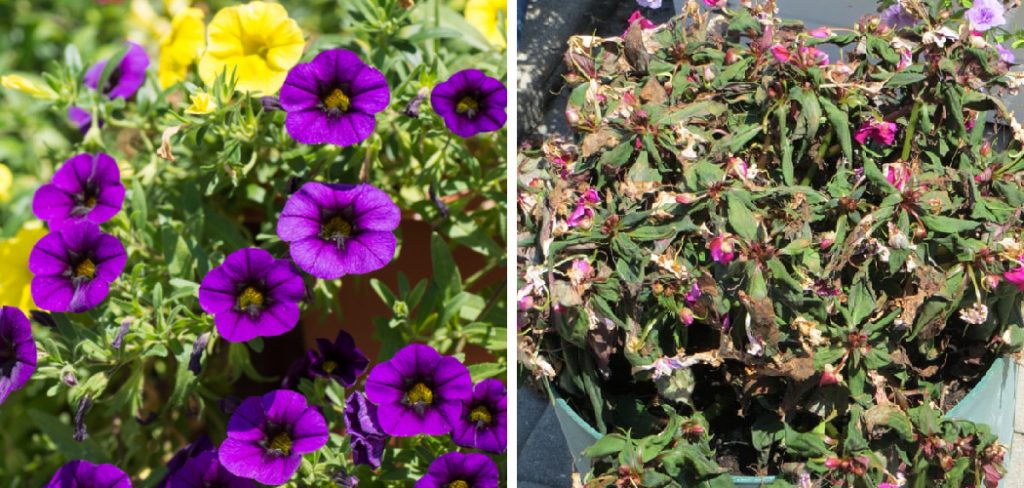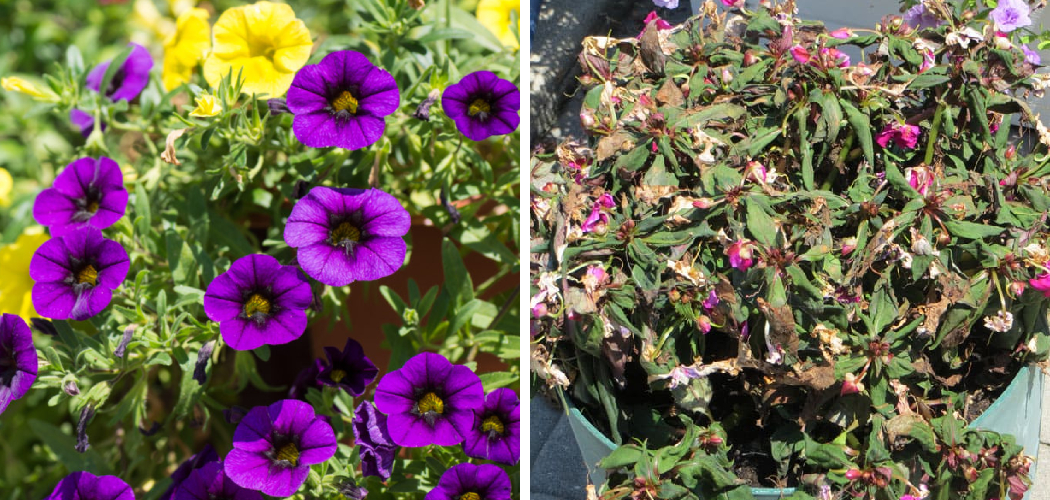To revive dying calibrachoa, provide proper watering, sunlight, fertilizer, and prune regularly. Calibrachoa plants may sometimes begin to show signs of decline, with wilted leaves, sparse growth, and reduced flowering.
However, by following a few simple steps, you can help revive your dying calibrachoa. Start by ensuring that your calibrachoa receives the right amount of water, as overwatering or underwatering can both lead to plant stress. Additionally, provide adequate sunlight for your calibrachoa, placing it in a location that receives at least six hours of direct sunlight each day.
Fertilize your plant regularly with a balanced fertilizer to provide essential nutrients. Lastly, prune your calibrachoa regularly to remove dead or damaged parts and promote new growth. By implementing these measures, you can revive and rejuvenate your dying calibrachoa to its former beauty.

Reasons For Calibrachoa’s Decline
Calibrachoa plants can decline due to a few reasons. Overwatering and poor drainage are major culprits, causing root rot. Insufficient sunlight may also contribute to their decline, as Calibrachoa requires full sun to thrive. Additionally, pests and diseases can take a toll on these plants, leading to wilting leaves and stunted growth.
To revive dying Calibrachoa, it’s important to address these issues. Adjust watering practices by allowing the soil to dry out between waterings and ensuring proper drainage. Place the plants in a sunny spot for at least six hours a day.
Regularly inspect the plants for pests and diseases, and take necessary measures to control them. By providing the right conditions and care, Calibrachoa can bounce back to health and display its vibrant blooms once again.
Identifying The Problem With Your Calibrachoa
If you notice leaf discoloration on your Calibrachoa plant, it may be a sign of trouble. Take a closer look at the roots to check for signs of rot that could be causing the plant’s decline. Pests can also be a problem, so thoroughly inspect the leaves and stems for any unwanted visitors.
Once you have identified the issue, take appropriate steps to revive your dying Calibrachoa.
How to Revive Dying Calibrachoa: Step by Step Guide
Calibrachoa plants can be revived by adjusting watering frequency and technique. Monitor soil moisture and only water when the top inch feels dry. Transplanting to a sunnier location can also benefit the dying calibrachoa, as it prefers full sun. Ensure the new spot has well-drained soil.
Additionally, inspect the plant for pests and diseases. Treat any infestations promptly using organic solutions or insecticidal soap. Regularly check for common issues like aphids, spider mites, or root rot. By addressing these factors, you can revive and restore your dying calibrachoa plants.
Remember, proper care, maintenance, and attention are essential for their overall health and vitality. So, keep a close eye on their watering, sunlight, and pest control needs to ensure their revival and long-lasting beauty.
Adjusting Watering Frequency And Technique
To revive a dying Calibrachoa, it is crucial to adjust the watering frequency and technique. Start by determining a proper watering schedule based on the plant’s needs. Check the soil moisture levels regularly, as overwatering can lead to root rot and under watering can cause the plant to wilt.
Implement appropriate watering techniques such as watering at the base of the plant and avoiding wetting the foliage. It’s important to provide enough water to moisten the entire root ball without soaking it. By following these guidelines, you can help revive your dying Calibrachoa and ensure its healthy growth.
Transplanting To A Sunnier Location
To revive a dying Calibrachoa, consider transplanting it to a sunnier location. Identify a suitable spot by assessing the amount of sunlight it receives. Preparing the new planting site is crucial for the plant’s rejuvenation. Ensure the soil is well-draining and rich in nutrients.
When transplanting, handle the Calibrachoa with care to minimize damage to its roots. Water the plant thoroughly after transplantation to encourage root establishment. With proper care and attention, your dying Calibrachoa can thrive and bloom once again. Remember, sunlight and soil conditions play a vital role in its revival, so choose the new location wisely.
By providing the ideal environment, you can breathe new life into your Calibrachoa.
Treating For Pests And Diseases
Calibrachoa plants can sometimes suffer from pests and diseases, but with the right treatments, you can revive them. Identifying common pests such as aphids, spider mites, and whiteflies is crucial. To combat these pests, use insecticidal soaps or neem oil sprays.
When it comes to diseases like botrytis blight or powdery mildew, removing infected plant parts and applying fungicides can be effective. Moreover, practicing good sanitation and proper watering techniques can prevent the spread of diseases. Additionally, the use of biological controls like beneficial insects or parasites can help eliminate pests.
Implementing these pest and disease control measures will ensure the revival of your dying Calibrachoa. Remember to regularly inspect your plants for any signs of pests or diseases and take immediate action to protect and nurture them.
Caring For Revived Calibrachoa
Calibrachoa plants can be revived with proper care. Regular maintenance is essential for their health. To provide adequate support, fertilize the plants appropriately. Consider using a balanced, slow-release fertilizer to avoid overfeeding. Additionally, pruning is crucial for rejuvenating the calibrachoa.
Trim back any dead or wilted portions to stimulate new growth. However, avoid excessive pruning as it may damage the plants. Remember to use sharp and clean tools to prevent the spread of diseases. By following these guidelines, you can successfully revive dying calibrachoa and enjoy their vibrant blooms throughout the year.
Providing Regular Maintenance
To revive dying Calibrachoa, it is crucial to provide regular maintenance. Keep a check on soil moisture levels to ensure it’s neither too dry nor overly saturated. Inspect the plant frequently for any signs of pests or diseases. If spotted, take immediate action to control and eliminate them.
Additionally, removing damaged or dead blooms promotes healthy growth. Regular deadheading encourages the production of fresh blooms, ensuring the plant’s vitality. By following these maintenance practices, you can revive your dying Calibrachoa and enjoy its beautiful flowers for a longer duration.
Fertilizing Appropriately
Calibrachoa plants, like any other plant, require proper nutrition to thrive. Understanding their nutritional needs is crucial in reviving dying calibrachoa. When it comes to fertilizing appropriately, choosing the right fertilizer is essential. Using fertilizers that are specifically formulated for calibrachoa plants can provide the necessary nutrients.
Additionally, applying fertilizer at the correct times is equally important. It is recommended to fertilize calibrachoa plants regularly but in moderation. Overfertilization can be harmful to the plants, so following the instructions on the fertilizer package is crucial. Understanding the nutritional requirements and fertilizing appropriately can help revive and maintain the health of dying calibrachoa plants.
By ensuring they receive the right nutrients at the right time, their vibrant colors and beautiful blooms can be restored.
Pruning For Rejuvenation
Reviving a dying calibrachoa is possible through the practice of pruning for rejuvenation. Pruning this delicate plant involves knowing when and how to do it effectively. Start by removing any dead or damaged stems and foliage, as these can hinder healthy growth.
By doing so, you promote branching and encourage new growth to revitalize your calibrachoa. Regular pruning helps maintain its shape and structure, preventing it from becoming straggly or leggy. Moreover, this practice improves air circulation and reduces the risk of disease.
Remember to use sharp, clean tools to make precise cuts, ensuring minimal damage to the plant. With proper pruning techniques, you can revive a dying calibrachoa and enjoy its vibrant blooms once again.
Frequently Asked Questions For How To Revive Dying Calibrachoa
Can I Revive My Calibrachoa Plant?
Yes, you can revive your calibrachoa plant by providing proper care, including regular watering and removing dead or damaged parts.
Can I Use Miracle Grow On Calibrachoa?
Yes, you can use Miracle Grow on calibrachoa for optimal growth and blooming.
How Often Should You Water Calibrachoa?
Water calibrachoa daily, ensuring the soil is moist but not waterlogged.
What Is The Root Rot In Calibrachoa?
Root rot in calibrachoa is a fungal disease that affects the roots, leading to wilting and decay.
Conclusion
To revive dying Calibrachoa plants, it is essential to take immediate action and follow a few crucial steps. By thoroughly assessing the factors causing the plant’s deterioration, such as watering issues, nutrient deficiencies, or pests, you can implement appropriate solutions.
First, adjusting watering practices and ensuring proper drainage can help prevent root rot and improve plant health. Secondly, providing balanced fertilization can replenish essential nutrients and encourage new growth. Additionally, regularly inspecting the plants for signs of pests and promptly treating any infestations can prevent further damage.
Remember to prune and deadhead regularly to promote healthy growth and prevent legginess. By following these simple tips, you can revive dying Calibrachoa plants and enjoy their beautiful blooms throughout the season. Keep dedicating proper care and attention, so your Calibrachoa can thrive and add vibrancy to your garden or containers.

